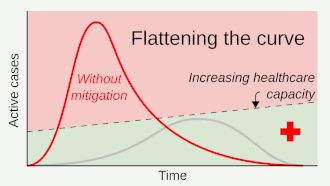Flatten the curve

Measures such as social distancing and stay-at-home orders slow down the spread of the disease.[1]
Flattening the curve is a public health strategy to slow down the spread of the COVID-19 virus during the COVID-19 pandemic. The curve being flattened is the epidemic curve, a representation of the number of infected people needing health care over time.
During an epidemic, a health care system can break down when the number of people infected passes the health care system's ability to take care of them.
Flattening the curve means slowing the spread of the epidemic so that the peak number of people requiring care at a time is reduced, and the health care system does not pass its capacity.
Flattening the curve relies on techniques such as quarantine, stay at home orders (lockdown), and social distancing.
Flatten The Curve Media
References
- ↑ Wiles, Siouxsie (2020-03-09). "The three phases of Covid-19—and how we can make it manageable". The Spinoff. Morningside, Auckland, New Zealand. Archived from the original on 2020-03-27. Retrieved 2020-03-09.
